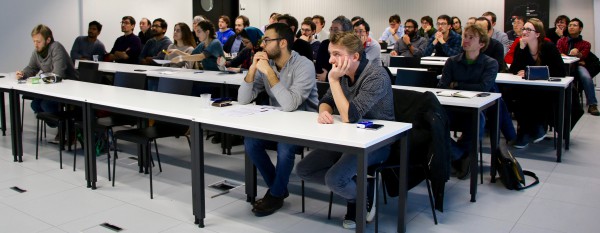MARVEL Junior Seminar — November 2018
The MARVEL Junior Seminars aim at intensifying interactions between the MARVEL Junior scientists belonging to different research groups located at EPFL. The EPFL community interested in MARVEL research topics is very welcome to attend. We believe that these events will be central for establishing a vibrant community.
Each seminar consists of two presentations of 25 minutes each, allowing to present on a scientific question in depth, each presentation being followed by 10 minutes for discussion. The discussion is facilitated and timed by the chairperson of the day whose mission is to ensure active lively interactions between the audience and the speakers.
Pizza is served at 11:45 in front of the auditorium (note that it will take place in ELA2 this time!), and after the seminar at 13:30 you are cordially invited for coffee and dessert to continue discussion with the speakers.

MARVEL Junior Seminar Organizing Committee — Francesco Ambrosio, Davide Campi, Edgar Engel, Gloria Capano, Michele Pizzochero, Kun-Han Lin, Francesco Maresca and Patrick Mayor
Check the list of the next MARVEL Junior Seminars here.
Abstract — AiiDA for gas adsorption in nanoporous materials - Daniele Ongari
D. Ongari, A. Yakutovich, L. Talirz and B. Smit
Gas adsorption, separation and storage are main challenges in the modern industry. The list of the known nanoporous structures is continuously expanding, always revealing new record-breaking materials for a specific gas adsorption application. In the case of crystalline materials, i.e., having a periodic unit cell, these frameworks can be directly modelled and tested computationally to assess their performances. This approach can be extended to many structures, finding the best candidates among thousands of reported materials or unveiling the complex relation between geometrical/chemical properties, and the adsorption performances. One of the most delicate aspects for a successful simulation is a good description of the framework-adsorbate interaction: analytical potentials (force fields) need to be employed in order to compute important properties such as the uptake, the Henry coefficient and the diffusivity of the adsorbate at finite temperatures. The choice of one off-the-shelf force field instead of another, its validation over more accurate DFT calculations, and its possible improvement, are therefore essential steps that need to be reiterated and properly documented whenever a new combination of materials and adsorbates is under investigation. We are currently working to use AiiDA’s workflows to manage these steps, not only to ensure the reproducibility of our screening studies but also to be able to expand them on the fly, adding the newest reported frameworks.
Abstract — Continuum models of the electrochemical diffuse layer in electronic-structure calculations - Francesco Nattino
Francesco Nattino1, Oliviero Andreussi2 and Nicola Marzari1
1 Theory and Simulations of Materials (THEOS) and National Centre for Computational Design and Discovery of Novel Materials (MARVEL), École Polytechnique Fédérale de Lausanne, Station 12, CH-1015 Lausanne, Switzerland
2Department of Physics, University of North Texas, Denton, TX 76207, USA.
The electrical diffuse layer is a structure that spontaneously forms at essentially any solvated interface, such that its presence in electrochemistry is ubiquitous. It consists of counterions attracted from the bulk liquid to electrostatically screen excess surface charges. While first-principles methods are desirable to describe any process occurring at the surface, fully-atomistic models of electrolyte solutions suffer from both conceptual and computational limitations. In this context, continuum solvation models represent a practical tool to bypass these difficulties and to account for the presence of the diffuse layer at electrified interfaces. However, despite the increasing popularity of continuum models in the field of materials science, even relatively simple observables such as the differential capacitance (DC) of single-crystal electrode surfaces remain challenging to model quantitatively. I will present and discuss the performance of a hierarchy of continuum diffuse-layer models that we have implemented and coupled to an atomistic first-principles description of a charged metal surface. In particular, I will compare computed DC values for the prototypical Ag(100) surface in an aqueous solution to experimental data, and validate in this way the accuracy of the models considered.
Low-volume newsletters, targeted to the scientific and industrial communities.
Subscribe to our newsletter